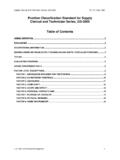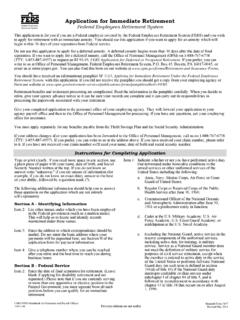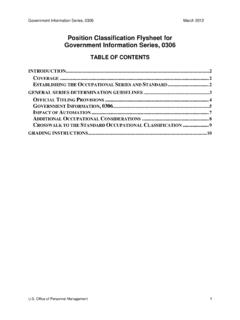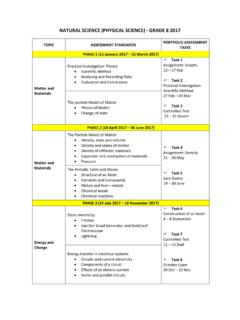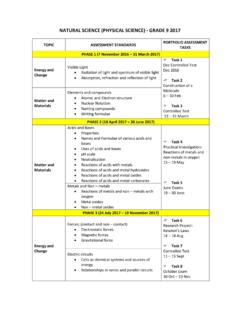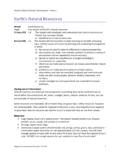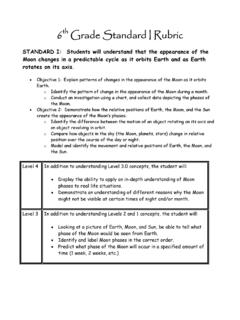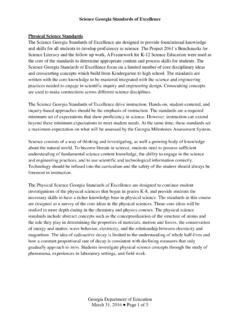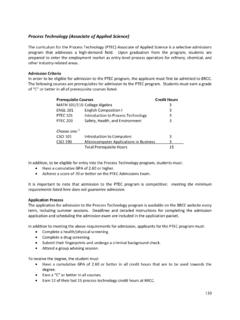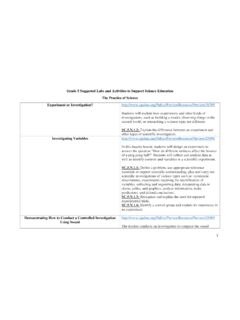Transcription of Job Family Position Classification Standard for ...
1 Professional Work in the physical Science Group, GS-1300 HRCD-4 December 1997. Job Family Position Classification Standard for Professional Work in the physical Science Group, GS-1300. Series Covered by This Standard : General physical Science GS-1301. Health Physics GS-1306. Physics GS-1310. Geophysics GS-1313. Hydrology GS-1315. Chemistry GS-1320. Metallurgy GS-1321. Astronomy & Space Science GS-1330. Meteorology GS-1340. Geology GS-1350. Oceanography GS-1360. Cartography GS-1370. Geodesy GS-1372. Land Surveying GS-1373. Forest Products Technology GS-1380. Food Technology GS-1382. Textile Technology GS-1384. Photographic Technology GS-1386. Table of Contents 2. 2. EVALUATING POSITIONS .. 3. 3. SERIES COVERAGE AND TITLES .. 4. GRADING CRITERIA .. 9. GS-1300-05 .. 9. GS-1300-07 .. 9. GS-1300-09 .. 10. GS-1300-11 .. 13. GS-1300-12 .. 16. GS-1300-13 .. 20. GS-1300-14 .. 23. GS-1300-15 .. 26. U. S. Office of Personnel Management 1.
2 Professional Work in the physical Science Group, GS-1300 HRCD-4 December 1997. COVERAGE. This Standard provides series definitions, titling instructions, and grading criteria for nonsupervisory professional positions in the physical sciences . These are typically positions with positive education requirements. This Standard cancels and supersedes standards for the following occupational series: General physical Science Series, GS-1301; Health Physics Series, GS-1306; Geophysics Series, GS- 1313; Hydrology Series, GS-1315; Chemistry Series, GS-1320; Metallurgy Series, GS-1321;. Astronomy and Space Science Series, GS-1330; Meteorology Series, GS-1340; Geology Series, GS-1350; Oceanography Series, GS-1360; Cartography Series, GS-1370; Geodesy Series, GS- 1372; Land Surveying Series, GS-1373; and Photographic Technology Series, GS-1386. In addition, this Standard provides coverage for the following occupational series for which published standards do not currently exist: Physics Series, GS-1310; Forest Products Technology Series, GS-1380; Food Technology Series, GS-1382; and Textile Technology Series, GS-1384.
3 INTRODUCTION. The grading criteria in Position Classification standards are based upon the definitions of grade levels found in title 5, Chapter 51 of the United States Code, supplemented by information gained through occupational studies conducted by the Office of Personnel Management. Department and agency heads are responsible for classifying positions within the intent of these standards and may delegate that responsibility. Positions are to be graded by comparing their duties, responsibilities, and qualification requirements to the grading criteria in one or more standards , sometimes called guides. This Standard provides specific criteria for nonsupervisory positions from GS-5 through GS-15. Each Position should be placed at the grade with the descriptive material that best represents it. The criteria includes appropriate language from the law, supplemented by more specific material. (The series criteria applies to all positions--research, development or operational, while the grade-level criteria applies only to nonresearch and nondevelopment positions.)
4 No Classification action should be taken based on language in the grade level definitions in the law alone. The language in the title 5 definitions is to be interpreted within the context of all the applicable grading criteria in this Standard . In grading a Position , users should review criteria for a range of grades to ensure a fuller understanding of the intent of criteria at a particular level. Criteria for a single grade should not be read in isolation. U. S. Office of Personnel Management 2. Professional Work in the physical Science Group, GS-1300 HRCD-4 December 1997. EVALUATING POSITIONS. Other standards may apply to physical science professional positions. Among these are the Research Grade Evaluation Guide, the Equipment Development Grade Evaluation Guide, the Test and Evaluation Grade Evaluation Guide, the Research Grants Grade Evaluation Guide, and the General Schedule Supervisory Guide. They may be used in conjunction with this Standard or independently as appropriate, depending upon the nature of the work.
5 For interdisciplinary work, standards from other occupations may apply, such as those for professional engineering or biological sciences (see Exclusions section). NOTE TO USERS: The illustrations in this job Family Standard are intended to show the nature of assignment and level of responsibility typical of professional physical science positions in a variety of work situations. They are designed to aid the user in determining the grade level of specific work situations relative to illustrations at lower and higher grade levels. Users should read all illustrations at the various grade levels and carefully consider all of the grading criteria presented in each illustration before making a final determination. In addition, users are cautioned to consider the entire wording of each illustration instead of relying strictly on such terms as expert, senior expert, site manager, project manager, etc. EXCLUSIONS. The following job Family occupational groups and series are excluded from coverage under this Standard : GS-0400 Biological sciences Group.
6 GS-0600 Medical, Hospital, Dental, and Public Health Group;. GS-0800 Engineering Group;. GS-1300 physical sciences --Technician Series; and GS-1500 Mathematics and Statistics Group. In addition, all technician positions, regardless of job Family designation, are specifically excluded from coverage under this Standard , including the following: GS-1311, physical Science Technician Series; GS-1341, Meteorological Technician Series; GS-1371, Cartographic Technician Series; and GS-1374, Geodetic Technician Series. U. S. Office of Personnel Management 3. Professional Work in the physical Science Group, GS-1300 HRCD-4 December 1997. SERIES COVERAGE AND TITLES. This Standard provides grading criteria for the 18 occupations listed below. Parenthetical titles may be added to the authorized titles shown at the option of the agency. The Supervisory prefix should be used in the title of positions that are classified by the appropriate supervisory guide.
7 The Research prefix should be used in the title of positions that are classified by the Research Grade Evaluation Guide. General physical sciences Series, GS-1301. This series includes positions that involve professional work in the physical sciences when there is no other more appropriate series, that is, the positions are not classifiable elsewhere. This series also includes work in a combination of physical science fields, with no one predominant. Titling: The basic title for this occupation is physical Scientist. Health Physics Series, GS-1306. This series includes positions that require primarily application of professional knowledge and competence in health physics, which is concerned with the protection of persons and their environment from unwarranted exposure to ionizing radiation. Titling: The basic title for this occupation is Health Physicist. Physics Series, GS-1310. This series includes positions that advise, administer, supervise, or perform research or other professional and scientific work in the investigation and application of the relations between space, time, matter, and energy in the areas of mechanics, sound, optics, heat, electricity, magnetism, radiation, or atomic and nuclear phenomena.
8 Titling: The basic title for this occupation is Physicist. Geophysics Series, GS-1313. This series includes professional scientific positions requiring application of knowledge of the principles and techniques of geophysics and related sciences in the investigation, measurement, analysis, evaluation, and interpretation of geophysical phenomena and artificially applied forces and fields related to the structure, composition, and physical properties of the earth and its atmosphere. Titling: The basic title for this occupation is Geophysicist. U. S. Office of Personnel Management 4. Professional Work in the physical Science Group, GS-1300 HRCD-4 December 1997. Hydrology Series, GS-1315. This series includes positions that involve professional work in hydrology, the science concerned with the study of water in the hydrologic cycle. The work includes basic and applied research on water and water resources; the collection, measurement, analysis, and interpretation of information on water resources; the forecast of water supply and water flows; and the development of new, improved or more economical methods, techniques, and instruments.
9 Titling: The basic title for this occupation is Hydrologist. Chemistry Series, GS-1320. This series includes all positions involving work that requires full professional education and training in the field of chemistry. This work includes the investigation, analysis, and interpretation of the composition, molecular structure, and properties of substances, the transformations which they undergo, and the amounts of matter and energy included in these transformations. This work includes the investigation, analysis, and interpretation of the composition, physical and chemical properties, molecular structure and chemical reactions of substances; the prediction of transformation they undergo; and the amount of matter and energy included in these transformations. Titling: The basic title for this occupation is Chemist. Metallurgy Series, GS-1321. This series includes positions that require primarily professional education and training in the field of metallurgy, including ability to apply the relevant principles of chemistry, physics, mathematics, and engineering to the study of metals.
10 Metallurgy is the art and science of extracting metals from their ores, refining them, alloying them and preparing them for use, and studying their properties and behavior as affected by the composition, treatment in manufacture, and conditions of use. Titling: The basic title for this occupation is Metallurgist. Astronomy & Space Science Series, GS-1330. This series includes professional positions requiring primarily application of the principles and techniques of astronomy and physics in the investigation and interpretation of the physical properties, composition, evolution, Position , distance, and motion of extraterrestrial bodies and particles in space. U. S. Office of Personnel Management 5. Professional Work in the physical Science Group, GS-1300 HRCD-4 December 1997. Titling: The basic titles for positions for this occupation are: Astronomer--This title includes professional positions concerned with observing and describing celestial objects; determining the positions, the motions and gravitational interactions of celestial objects; and investigating related aspects of stellar and galactic dynamics.




